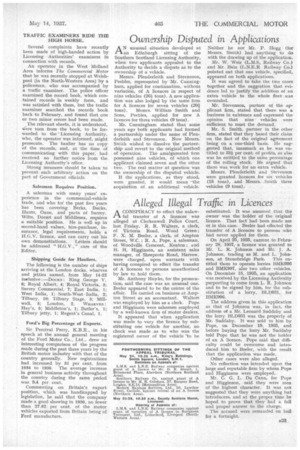Ownership Disputed in Applications A N unusual sit cation developed
Page 33

If you've noticed an error in this article please click here to report it so we can fix it.
at an Edinburgh sitting of the Southern Scotland Licensing Authority, when two applicants appealed to the Authority to decide a dispute as to the ownership of a vehicle.
Messrs. Plenderleith and Stevenson, Peebles, represented by Mr. Cunningham, applied for continuation, without variation, of A licences in respect of nine vehicles (26-i tons). A new application was also lodged by the same firm for A licences for seven vehicles (20 tons). Messrs. William Smith and Sons, Peebles, applied for new A licences for three vehicles (9 tons).
Mr. Cunningham stated that some years ago both applicants had formed a partnership under the name of Plenderleith and Stevenson. Now Messrs. Smith wished to dissolve the partnership and revert to the original method of operation. The amalgamated firm possessed nine vehicles, of which one applicant claimed seven and the other two. The real matter at question was the ownership of the disputed vehicle.
If the applications, as they stood, were granted, it would mean -the acquisition of an additional vehicle.
Neither he nor Mr. P. Hogg (for Messrs. Smith) had anything to do with the drawing up of the application.
Mr. W. Weir (L.M,S, Railway Co.) and Mr. Bain (L.N.E.R Railway Co.) pointed out that one vehicle, specified, appeared on both applications.
It was agreed to take the two cases together and the suggestion that evidence led to justify the addition of an extra vehicle to the whole fleet was overruled.
Mr. Stevenson, partner of the applicant firm, stated that there was a business in existence and expressed the opinion that nine vehicles were sufficient to meet the .dernand.
Mr. S. Smith, partner in the other firm, stated that they based their claim on the fact of the original agreement being on a one-third basis. He suggested that, inasmuch as he was entitled to 33* per cent. of profits, so also was he entitled to the same percentage of the rolling stock. He argued that there was work for an extra vehicle.
, Messrs. Plenderleith and Stevenson were granted licences for six vehicles (18 tons), and Messrs. Smith three vehicles (9 tons).




















































































